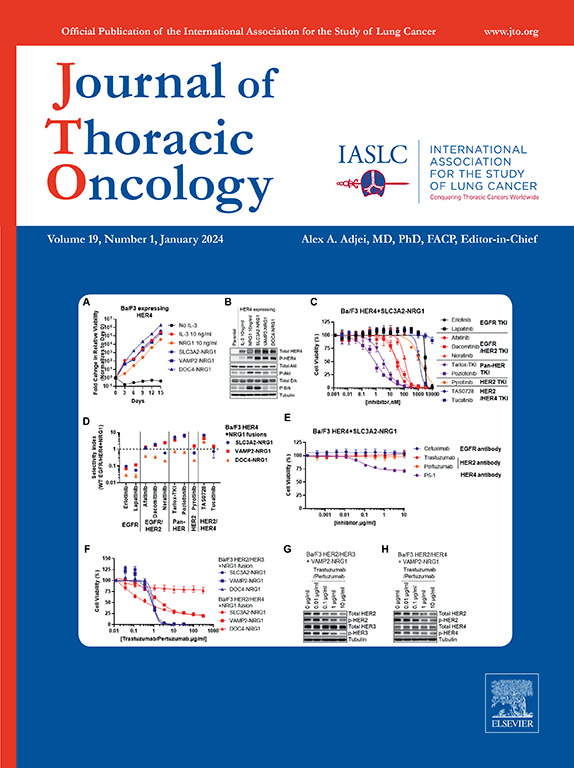Pembrolizumab 联合或不联合 Olaparib 治疗对一线 Pembrolizumab 加化疗有反应的转移性鳞状非小细胞肺癌。
IF 21
1区 医学
Q1 ONCOLOGY
引用次数: 0
摘要
背景:PARP抑制剂能上调PD-L1的表达并促进免疫介导的反应,可能会提高转移性鳞状NSCLC患者一线抗PD-1疗法的疗效:在这项随机、双盲、3 期试验(NCT03976362)中,既往未经治疗的 IV 期鳞状 NSCLC 成人患者接受了 4 个周期的诱导治疗(pembrolizumab 200 mg Q3W 加卡铂和紫杉醇或 nab-紫杉醇)。疾病得到控制的患者随机接受 31 个周期的 pembrolizumab 200 毫克 Q3W 加 olaparib 300 毫克口服,每天两次或安慰剂治疗。无进展生存期(PFS)和总生存期(OS)是双重主要终点。无进展生存期在中期分析2(IA2;最终无进展生存期分析)中进行检测;OS在最终分析中进行检测:851名患者接受了诱导治疗;296名患者随机接受了pembrolizumab加奥拉帕利治疗,295名患者随机接受了pembrolizumab加安慰剂治疗。在中位随访27.1个月的IA2阶段,pembrolizumab联合olaparib组的中位(95% CI)PFS为8.3(6.7-9.7)个月,pembrolizumab联合安慰剂组为5.4(4.1-5.6)个月(HR,0.77 [95% CI,0.63-0.93];P=0.0040[单侧优效边界P=0.003时无显著性]。在中位随访 33.4 个月的最终分析中,中位(95% CI)OS 分别为 19.1(15.9-22.2)个月和 18.6(16.0-21.6)个月(HR,1.01 [95% CI,0.83-1.24];P=0.5481)。分别有76.5%和65.1%的患者出现治疗相关不良事件:结论:与pembrolizumab加安慰剂相比,在转移性鳞状NSCLC的维持治疗中添加奥拉帕利并不能显著改善PFS,PFS和OS均未达到预设的统计学显著性界限。未发现新的安全信号。本文章由计算机程序翻译,如有差异,请以英文原文为准。

Pembrolizumab With or Without Maintenance Olaparib for Metastatic Squamous NSCLC That Responded to First-Line Pembrolizumab Plus Chemotherapy
Introduction
Poly (adenosine diphosphate-ribose) polymerase inhibitors can up-regulate programmed cell death-ligand 1 expression and promote immune-mediated responses and may improve efficacy of first-line anti‒programmed cell death protein 1‒based therapies in patients with metastatic squamous NSCLC.
Methods
In this randomized, double-blind, phase 3 trial (NCT03976362), adults with previously untreated stage IV squamous NSCLC received four cycles of induction therapy (pembrolizumab 200 mg every 3 weeks plus carboplatin and paclitaxel or nab-paclitaxel). Patients with disease control were randomized to 31 cycles of pembrolizumab 200 mg every 3 weeks plus olaparib 300 mg orally twice daily or placebo. Dual primary end points were progression-free survival (PFS) and overall survival (OS). PFS was tested at interim analysis 2 (the final PFS analysis); OS was tested at final analysis.
Results
A total of 851 patients received induction treatment; 296 were randomized to pembrolizumab plus olaparib and 295 to pembrolizumab plus placebo. At interim analysis 2, with median follow-up of 27.1 months, median (95% confidence interval [CI]) PFS was 8.3 (6.7‒9.7) months in the pembrolizumab plus olaparib group and 5.4 (4.1‒5.6) months in the pembrolizumab plus placebo group (hazard ratio = 0.77, 95% CI: 0.63‒0.93, p = 0.0040 [not significant at a one-sided superiority boundary of p = 0.003]). At final analysis, with median follow-up of 33.4 months, median (95% CI) OS was 19.1 (15.9‒22.2) and 18.6 (16.0‒21.6) months, respectively (hazard ratio = 1.01, 95% CI: 0.83‒1.24, p = 0.5481). Treatment-related adverse events occurred in 76.5% and 65.1% of patients, respectively.
Conclusions
Adding olaparib to pembrolizumab as maintenance therapy for metastatic squamous NSCLC did not significantly improve PFS versus pembrolizumab plus placebo; neither PFS nor OS met the prespecified statistical significance boundary. No new safety signals were identified.
Trial registration
ClinicalTrials.gov, NCT03976362.
求助全文
通过发布文献求助,成功后即可免费获取论文全文。
去求助
来源期刊

Journal of Thoracic Oncology
医学-呼吸系统
CiteScore
36.00
自引率
3.90%
发文量
1406
审稿时长
13 days
期刊介绍:
Journal of Thoracic Oncology (JTO), the official journal of the International Association for the Study of Lung Cancer,is the primary educational and informational publication for topics relevant to the prevention, detection, diagnosis, and treatment of all thoracic malignancies.The readship includes epidemiologists, medical oncologists, radiation oncologists, thoracic surgeons, pulmonologists, radiologists, pathologists, nuclear medicine physicians, and research scientists with a special interest in thoracic oncology.
 求助内容:
求助内容: 应助结果提醒方式:
应助结果提醒方式:


